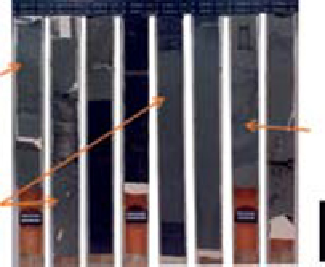Geoscience Reference
In-Depth Information
(C)
(A)
Channel
storey &
storey set
base
Clay-
dominated
abandon-
ment fill
Sheared
massiv
sandstone
Slumpfolded
sandstone-
mudstone
unit with
sandstone
injections
Channel-base
shape drape
Channel
storey
bases
Shale clast
conglo-
merate
Massiv,
sharp-based
and sharp-
topped
sandstones
Muddy
channel-
plug
(B)
(D)
Hemipelagic
abandon-
ment drape
Hemipelagic
abandon-
ment drape
Slumpfolded
sandstone-
Coarse and
massiv, clay-
draped,
sharp-based
and sharp-
topped
sandstones
Stratified
pebbly
sandstones
Rip-up clasts
within
pebbly
sandstones
Fig. 8.
Core photos illustrating typical features of the coarser and deformed facies associations. (A) Channel-belt association,
with multistorey channel-fill unit, basal Danian or basal Tang Formation sandstones (i.e. the Våle heteroliths), 6305/8-1.
(B) Layered braided fan or channel-to-lobe transition association comprised by coarse to pebbly sandstones, basal Danian
Egga sandstone unit, well 6305/8-1. (C) Megabed association with sharp-based and sharp-topped, thick to very thick-bedded
massive, medium-grained sandstones, some with sheared basal parts and interbedded slump-deformed sandstone-
mudstone couplets with sandstone injectites, uppermost Springar Formation sandstones, well 6305/7-1. (D) Deformed
central to peripheral lobe / crevasse splay facies alternating with clay-draped sharp-based and sharp-topped, thick, coarse-
grained sandstones, the latter representing channel-to-lobe transition facies, Danian upper Egga sandstone unit, well 6305/8-1.
Length of an individual core slab is 1 metre, whereas width is 10 centimetres.
above). The component facies, together with abun-
dant scoured basal bed boundaries, point to depo-
sition from repeated, shallow channelised or
scouring flows that migrated relatively freely across
the sediment (fan) surface. The channels were
filled by and alternated laterally with down-current
migrating bedforms or bars (Figs 8B and 10;
Table 3). Such features are common in a 'braided'
channelised lobe or the channel-to-lobe transition
area (e.g. Gardner
et al
., 1996; Johnson
et al
., 2001;
Lien
et al
., 2003; Decker
et al
., 2004; Gervais
et al
.,
2006; Milli
et al
., 2007; Sweet
et al
., 2007; Deptuck
et al
., 2008: Jegou
et al
., 2008), which is favoured
as the overall setting for this association. The sand-
stone strata represent both channel (basal lags and
barforms) as well as interchannel (overbank wedges
and splays) deposits. Bedset motifs probably reflect
variable scenarios of channel-filling and avulsion
or lateral migration (e.g. Grecula
et al
., 2003a;
O'Byrne
et al
., 2007).
The central lobe association consists of layered to
amalgamated packages of medium-bedded to thick-
bedded, stratified and cross-stratified turbiditic
sandstones, as well as some Bouma-type T
a
(thick,
massive sandstones) and T
ab
turbidites. Stratified
and massive sandstones are commonly amalga-
mated, whereas thin hemipelagic mudstones sepa-
rate T
a
/T
ab
beds and stratified sandstones. The facies
are arranged in coarsening-upwards and thickening-
upwards to fining-upwards and thinning-upwards
as well as more irregular vertical stacking motifs,
typically several metres to nearly ten metres-thick
(Table 3; Fig. 9). This association represents a
mixture of deposits from alternating channelised or




Search WWH ::

Custom Search